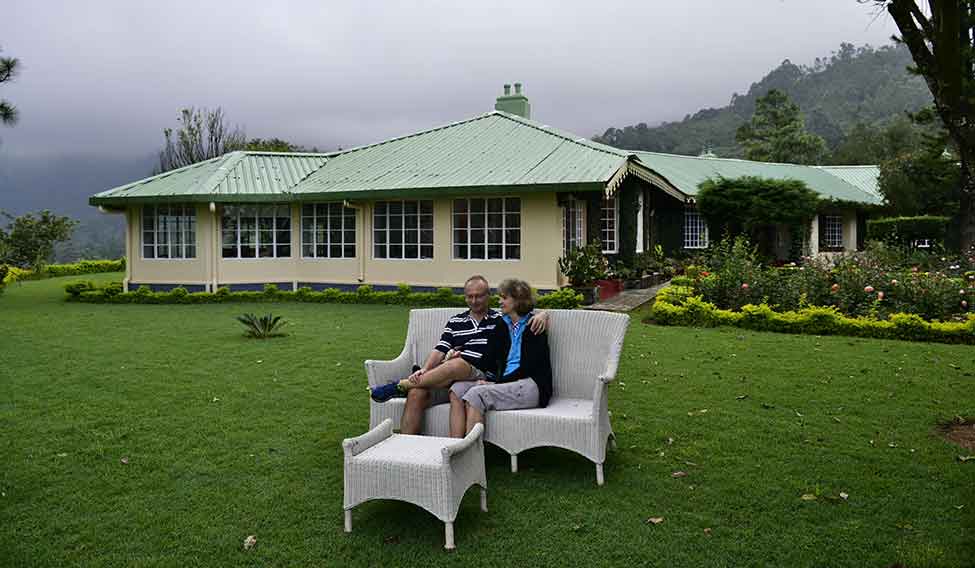With dipping tea production and exports, many estate owners have been looking for other sources of income, and some of them have turned to tea tourism. The pristine surroundings, unmatched verdure and colonial bungalows hold irresistible charm for many tourists.
Staying at one of these bungalows is like lounging in the lap of luxury, not unlike how the early owners, the British planters, once lived. A visitor can spend a few days in the estate, sipping tea, talking to workers—whose huts dot the landscape—and learning about the process of making tea.
It would cost a couple Rs6,500 to Rs33,000 a day, depending on the bungalow and the services provided.
The buildings are architectural marvels and some have furniture as old as the structures. Although made by the British, the architecture has Chinese and local influences, which, if anything, have enriched the bungalows.
For more images: Colonial bungalows nestled in mystical tea gardens
Then there is the opportunity to study the varieties of tea, which owe their distinctive qualities to geography, climate, soil type, flora and fauna. Unlike most Indian teas, the Darjeeling varieties are made from the small leaves of the Camellia sinensis plant. Assam tea, on the other hand, is made from the large leaves of the Assamica strain of Camellia sinensis. Down south, Tamil Nadu and Kerala are home to a rich variety of tea made using the CTC (crush, tear, curl) method.
The workers at these bungalows mostly come from families that have been on these plantations for long. For instance, Devendra Subba, the caretaker of the Goomtee Tea Garden Bungalow in Darjeeling, was raised in here by his father. Subba’s knowledge of the soil and the locality is staggering, and he takes care of 20 varieties of flowers in the bungalow's garden.
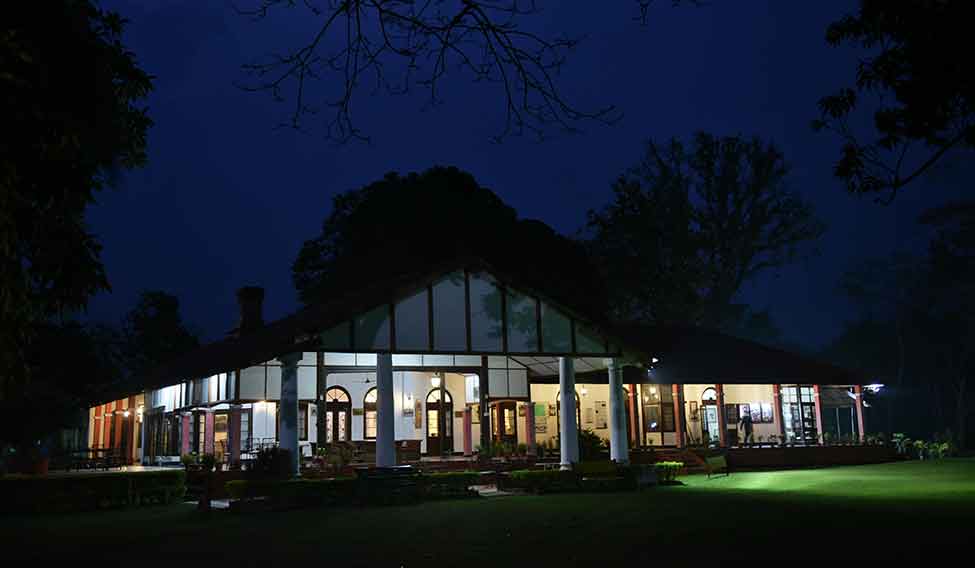 The Burra Sahib Bungalow in Jorhat, Assam.
The Burra Sahib Bungalow in Jorhat, Assam.
I visited eight tea garden bungalows in Assam, Darjeeling, Tamil Nadu and Kerala, and saw different topography, climate and architecture. One aspect, however, was common—they all quenched my thirst.
Burra Sahib Bungalow
It is only fitting that Assam be the first destination. After all, the state is known for its enduring romance with tea, and the 125-year-old Burra Sahib Bungalow, in the Sangsua Tea Estate in Jorhat, does justice to that relationship. George Williamson and Co, the British company that once owned the estate, used the bungalow as a guest house for visiting agents, or Burra Sahib, as the estate workers called them.
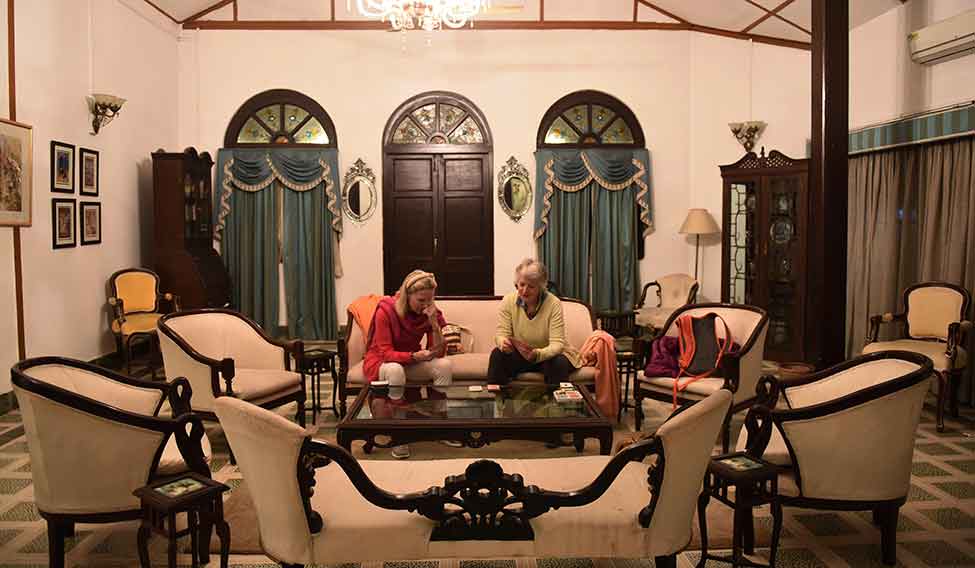 Old-world charm: Clare Ferguson and Jennifer Hammerson from Britain play cards at Mistry Sahib's Bungalow in Jorhat, Assam.
Old-world charm: Clare Ferguson and Jennifer Hammerson from Britain play cards at Mistry Sahib's Bungalow in Jorhat, Assam.
The days can be spent lazing around in the verandahs, with a book in hand or by gazing at the view. For golf enthusiasts, the retreat offers a tee break. Near the bungalow, there is a 150-acre, 18-hole golf course. A fairway to heaven, if you will.
Mistry Sahib’s bungalow
The spacious bungalow in Gatoonga Tea Estate in Jorhat was once home to an assistant factory manager, lovingly called Mistry Sahib for his knowledge of mechanics. Now called Banyan Grove, the bungalow retains its old-world charm and attracts visitors from all over the world. Clare Ferguson and Jennifer Hammerson from Britain were playing cards when I joined them for a glass of beer.
The mornings are misty and the evenings magical, mostly because of the warm glow of the fireplace and the diffused light of the timeworn chandeliers.
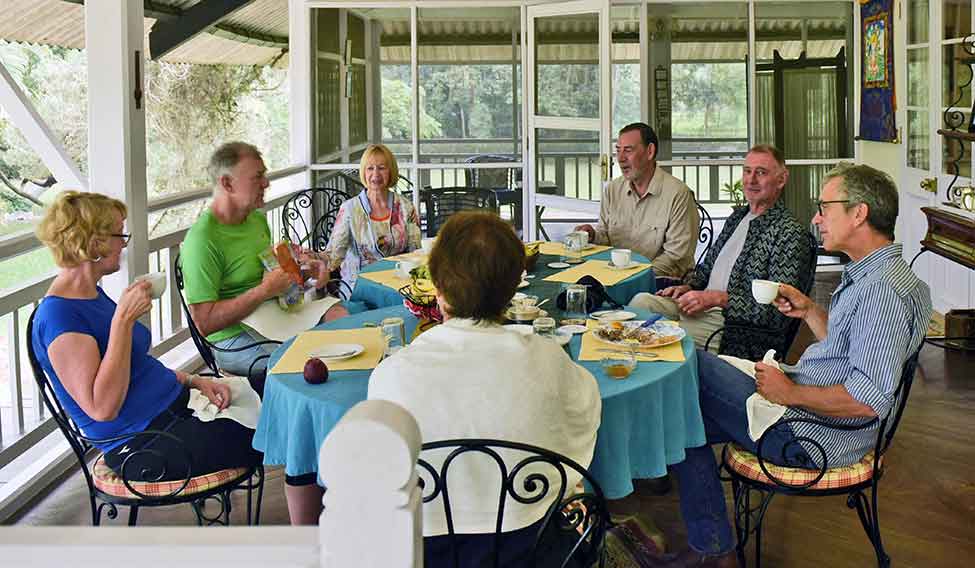 Green, serene: A group of Australian tourists having breakfast at the Mancotta Chang Bungalow in Dibrugarh.
Green, serene: A group of Australian tourists having breakfast at the Mancotta Chang Bungalow in Dibrugarh.
And, outside, looking over the bungalow, is the 190-year-old banyan tree for which the bungalow was renamed.
Mancotta Chang Bungalow
This beautiful bungalow stands on a dozen stilts (locally called chang ghar) on the outskirts of Dibrugarh, in upper Assam, and offers a breathtaking view of the Brahmaputra. Originally owned by English East India Company, it was the residence of the superintendent manager of the tea estate. The Chinese influence on the architecture is evident from the handcrafted wooden nails used in the flooring.
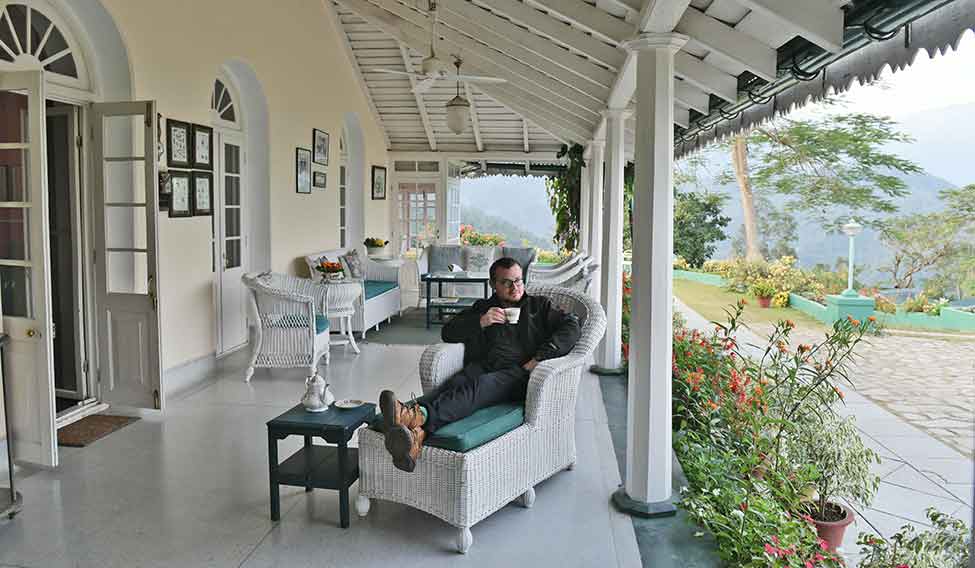 Brew and a view: A visitor at a Glenburn Tea Estate bungalow in Darjeeling.
Brew and a view: A visitor at a Glenburn Tea Estate bungalow in Darjeeling.
Of the tea garden bungalows in the region, this one offers a perfect combination of the lavish British lifestyle and classic colonial architecture.
Glenburn Tea Estate bungalows
The Kangchenjunga in sight and tea in serenity. This is what the Glenburn Tea Estate bungalows promise. Located in Takdah, Darjeeling, the retreat has two bungalows, each with four suites, gardens, verandahs and terraces. Two rivers flow through the estate and there is a forest nearby.
Started by a Scottish tea company in 1859, the plantation retreat was later taken over by the Prakash family, one of India's leading tea planters. The original planter’s bungalow, a magnificent structure, was restored to its original glory in 2002.
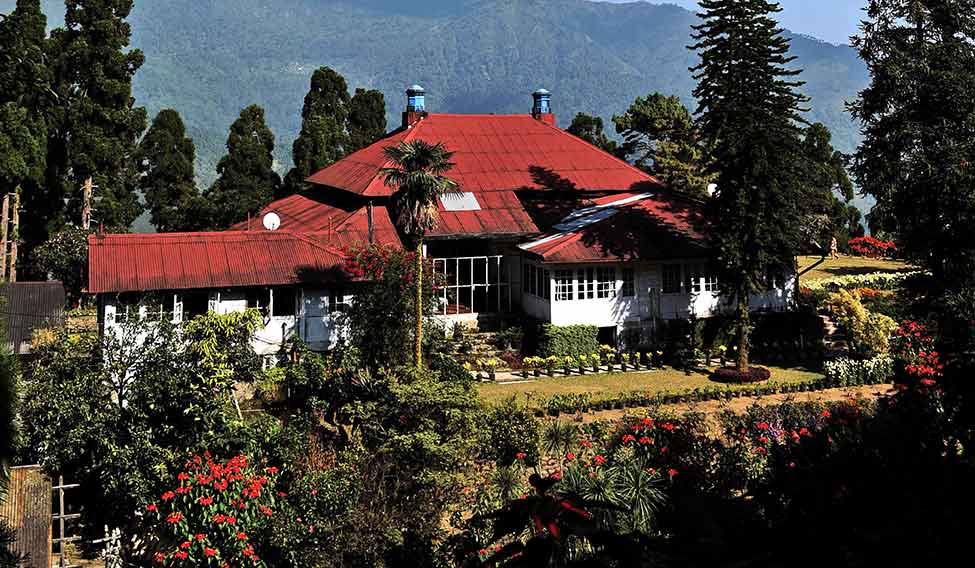 Goomtee Tea Estate Bungalow in Darjeeling.
Goomtee Tea Estate Bungalow in Darjeeling.
During a lunchtime chat, manager Parvez Khan told me that writer Khushwant Singh was one of the regulars here. Former Australian cricketer Greg Chappell and his wife, Judy, would also visit.
Goomtee Tea Estate Bungalow
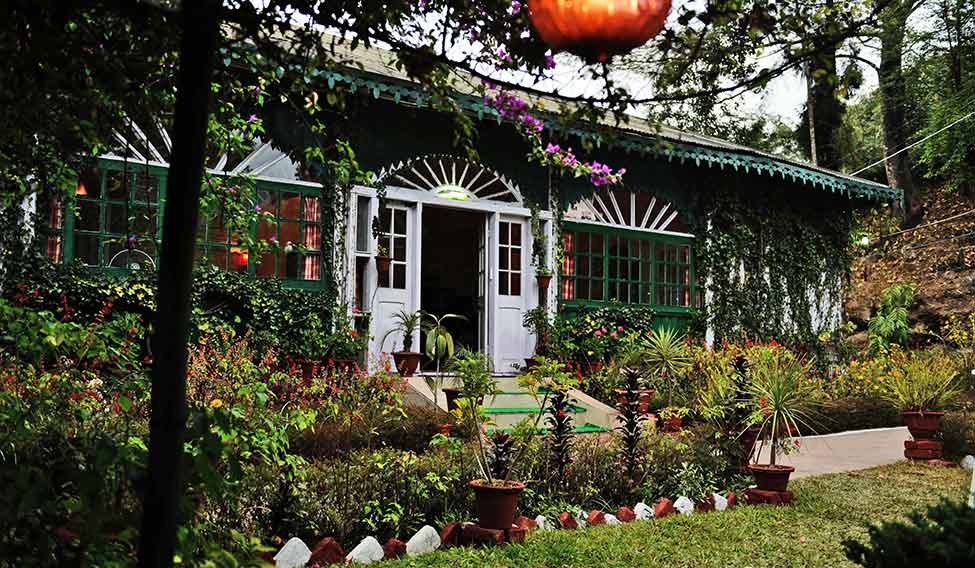 Steinthal Bungalow is in one of the oldest tea estates in Darjeeling.
Steinthal Bungalow is in one of the oldest tea estates in Darjeeling.
In 1899, Henry Montgomery Lennox, the founder of the Goomtee Tea Estate, built this bungalow for his family. Located in Kurseong in Darjeeling district, the bungalow, at an altitude of 4,150 feet, offers a stunning view of the surrounding valleys and mountains. In 1956, the estate was taken over by the Kejriwal and Prasad families, but they have retained the colonial charm. The estate is known to produce the finest orthodox Darjeeling tea, a cup of which I was sipping when I saw two framed letters addressed to an N. Prasad. These letters from prime minister Indira Gandhi thanked him profusely for flowers and tea sent to her in Delhi. Ashok Kumar, one of the directors of the estate, said the 1970 Bengali film Sagina Mahato, starring Dilip Kumar and Saira Banu, was shot here.
Steinthal and Singtom bungalows
The Steinthal and Singtom tea estates are among the oldest in Darjeeling. The Singtom resort opened in 2012 and the bungalow, built in 1862 for the director of the estates, now thrives as a tourist hotspot. The Steinthal bungalow was named after Father Steinthal, a German priest who started plantation in some parts of the garden. Right next door is the Singtom bungalow.
In 1999, the Chirimar family of Kolkata took over the estates and turned them into organic gardens.
A river babbles nearby, songbirds trill nonstop and the Kangchenjunga towers over the beautiful retreat. The most amazing residents, however, are the tea bushes that have survived since 1852.
Talayar Valley Bungalow
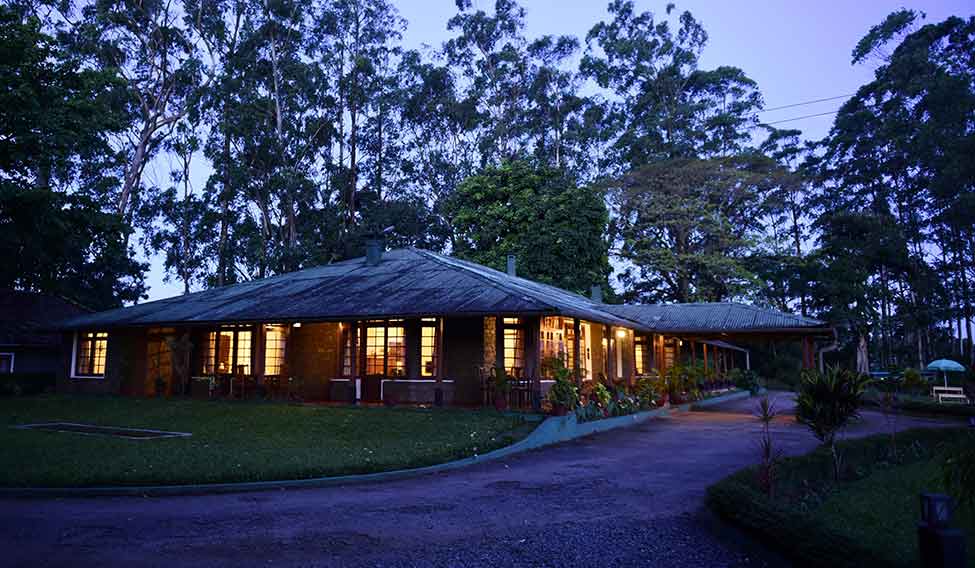 Day-night beauty: Stanmore Garden Bungalow in Valparai, Tamil Nadu.
Day-night beauty: Stanmore Garden Bungalow in Valparai, Tamil Nadu.
From the east, I headed south, to Kerala and Tamil Nadu, where the British found another home for tea in the mid-19th century. My first stop was the Talayar Valley Bungalow, 18km from Munnar. Quaint and serene, Talayar was originally the bungalow of a 19th century British plantation manager. The walls outside are covered with creepers and lined with seasonal flowers, and it is warm and cozy inside. With its four suites, cigar room, rose garden and what used to be a lawn tennis court, it is as British as British can be.
Stanmore Garden Bungalow
I passed 40 hairpin bends to reach Valparai in Tamil Nadu. It was worth it. The Stanmore Garden Bungalow, in the Anamalai Hills, welcomed me with the charm and grandeur of a old-style tea plantation bungalow. A long verandah runs around the building, and a butler runs around attending to your whims. The website of Briar Tea Bungalows, which owns the property, says it was built about 90 years ago, with rosewood and teakwood interiors. Sophisticated and luxurious, the bungalow, in the middle of thick reserve forest, offers travellers an unmatched solitude. The retreat has many wooden chalets, each with a personality of its own.



